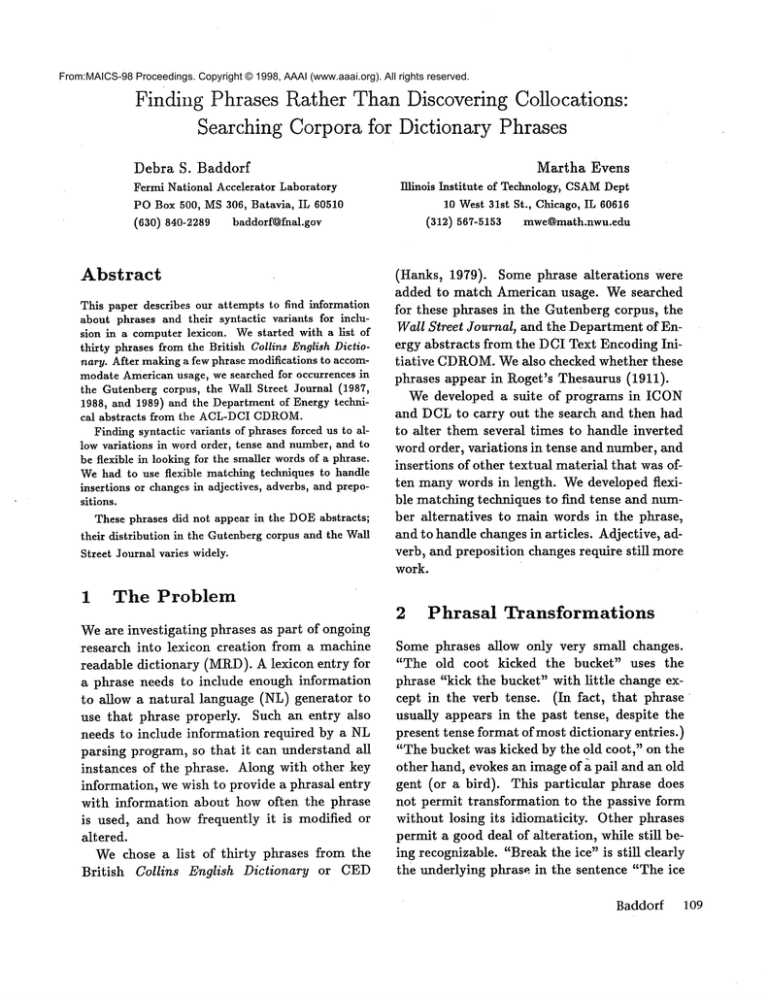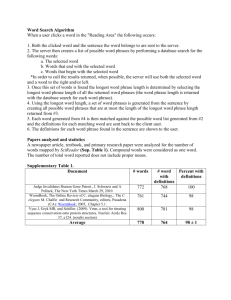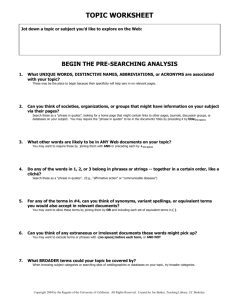
From:MAICS-98 Proceedings. Copyright © 1998, AAAI (www.aaai.org). All rights reserved.
Finding Phrases Rather Than Discovering Collocations:
Searching Corpora for Dictionary Phrases
Debra S. Baddorf
Fermi National Accelerator
Martha Evens
Laboratory
Illinois
Abstract
This paper describes our attempts to find information
about phrases and their syntactic variants for inclusion in a computer lexicon. We started with a list of
thirty phrases from the British Collins English Dictionary. After making a few phrase modifications to accommodate American usage, we searched for occurrences in
the Gutenberg corpus, the Wall Street Journal (1987,
1988, and 1989) and the Department of Energy technical abstracts
from the ACL-DCI CDROM.
Finding syntactic variants of phrases forced us to allow variations in word order, tense and number, and to
be flexible in looking for the smaller words of a phrase.
We had to use flexible matching techniques to handle
insertions or changes in adjectives, adverbs, and prepositions.
These phrases did not appear in the DOEabstracts;
their distribution
in the Gutenberg corpus and the Wall
Street Journal varies widely.
Institute
of Technology, CSAM
Dept
10 West 31st St., Chicago, IL 60616
PO Box 500, MS306, Batavia, IL 60510
baddorf~fnal.gov
(630) 840-2289
(312) 56"/-5153
mwe@math.nwu.edu
(Hanks, 1979). Some phrase alterations were
added to match American usage. We searched
for these phrases in the Gutenberg corpus, the
Wall Street Journal~ and the Department of Energy abstracts from the DCI Text Encoding Initiative CDROM.
Wealso checked whether these
phrases appear in l~oget’s Thesaurus (1911).
We developed a suite of programs in ICON
and DCLto carry out the search and then had
to alter them several times to handle inverted
word order, variations in tense and number, and
insertions of other textual material that was often manywords in length. Wedeveloped flexible matching techniques to find tense and number alternatives to main words in the phrase,
and to handle changes in articles. Adjective, adverb, and preposition changes require still more
work.
1
The Problem
Weare investigating phrases as part of ongoing
research into lexicon creation from a machine
readable dictionary (MtI.D). A lexicon entry for
a phrase needs to include enough information
to allow a natural language (NL) generator
use that phrase properly. Such an entry also
needs to include information required by a NL
parsing program, so that it can understand all
instances of the phrase. Along with other key
information, we wish to provide a phrasal entry
with information about how often the phrase
is used, and how frequently it is modified or
altered.
We chose a list of thirty phrases from the
British Collins English Dictionary or CED
2
Phrasal Transformations
Some phrases allow only very small changes.
"The old coot kicked the bucket" uses the
phrase "kick the bucket" with little change except in the verb tense. (In fact, that phrase
usually appears in the past tens% despite the
present tense format of most dictionary entries.)
"The bucket was kicked by the old coot," on the
other hand, evokes an image of a pail and an old
gent (or a bird). This particular phrase does
not permit transformation to the passive form
without losing its idiomaticity. Other phrases
permit a gooddeal of alteration, while still being recognizable. "Break the ice" is still clearly
the underlying phrase in the sentence "The ice
Baddorf
109
to scan a text corpus and, using statistical analysis, report which words were typically used
together.
XTRACThas been honed for use
with a text corpus of Associated Press financial accounts. Su, Wu, & Chang (1994) used
n-grams and added part of speech information
to find technical compoundnoun collocations in
a small corpus of technical manuals. Evans
Zhai (1996) used n-grams plus linguistic heuristics to search for noun phrases in a corpus consisting of three months of AP newswire stories. Ikehara, Shirai, & Uchino (1996)have
used n-gram statistics plus additional steps to
find both interrupted and uninterrupted collocations of characters in a corpus of three months
of Japanese newspaper articles. Shimohata, Sugio, & Nagata (1997) used n-grams plus an "entropy value" to retrieve collocations and limit
extraneous matches. They used a computer
manual as the data set.
Chen ~ Chen (1994) located noun phrases
the SUSANNE
corpus by using parsing methods and linguistic
knowledge. Lauer (1995)
compared statistical analysis of a corpus with
parsing techniques for locating noun compounds. He felt that a dependency grammar
was more accurate than the adjacency model
(n-grams) for his task. His corpus was composed of the 8 million word Grolier’s encyclopedia. Habert, Naulleau, & Nazarenko (1996)
used parsing methods to find noun collocations
in medium-sized corpora, where there may not
be sufficient wordsto support a statistical analysis. Kim (1996) used a WSJcorpus to search
Corpora As Data Source
3
for collocations of words that can be grouped
Wehave seen phrasal forms being investigated
and labelled as proper nouns: corporate names,
with introspection, with carefully balanced inindividuals’ names, etc.
As we see, text corpora have been examined
formant testing, and with questionnaires which
quickly become confusing. Each of these techfor word collocations, using statistics and other
niques focussed on a small set of phrases and a
techniques to locate words which are frequently
small number of data sources (informants).
used together. Weare now examining several
corpora to find instances of predefmedphrases,
Text corpora are being used quite frequently
today, due to the availability of fast computers,
rather than to find out what unknownphrases
may exist. Weare looking for phrases that a
large disks and cheap memory, and the availdictionary considers commonenough to merit
ability of published corpora on CDt%OMs.
Cordefinition. Instead of "found collocations" these
pora provide a huge data set of text, and allow
are "sought collocations." Wehope to gain data
manydifferent types of research questions.
Smadja (1992) used a tool called XTRACT, about written usage of phrases and the trails-
can be broken by telling a good joke before a
speech."
Fraser (1970) proposed that phrasal modifications follow a hierarchy of allowable transformations. He decided how certain phrases could
transform by "self-examination:" he asked himself which phrases did or did not sound right
when modified in each manner.
l~eagan (1987) rearranged Fraser’s levels
somewhat, and provided clear examples. He
used several small groups of nominally paid subjects as his resource to determine allowable alterations to a small set of phrases.
Gibbs and various associates performed several sets of experiments on idiom usage and human memory (Gibbs & Gonzales, 1985) (Gibbs
Nayak, 1989). These experiments involved
volunteers being shownnumerous idioms, carefully mixed with filler material, so informants
did not focus only on the idioms.
Further investigation was done locally into
phrasal modification. To study this problem,
a set of questionnaires was developed, and answered by a small set of informants. The results have not yet been processed. A problem
with this technique became obvious to us immediately. Subjects (including ourselves) complained that after a very few questions, all
choices listed on the questionnaires began to
look equally wrong or right, so that one could
no longer rely on one’s judgement.
110 MAICS-98
formations of phrases. Wecan, with time, look.
for a larger set of phrases than has been possible with human informants. We are also using
writings from a larger number of people than is
possible using survey techniques.
4
The Limitations
Search
of a Corpus
A cartoon we saw recently showed an anthropomorphic kitchen saucepan or pot, holding a
phone to his ear, and the caption "The pot calling the kettle’s voice-mail." This is clearly a
spoof or alteration of the familiar phrase "the
pot calling the kettle black." It is also clearly
not going to appear in most forms of written
text in our corpora. The point we wish to make
is that many phrases that are used frequently
in casual speech or text may not show muchusage in a printed text corpus. Wewill makenote
of this for users of our lexicon entries. Corpus
statistics tell us only about written phrase usage, and may be very different from statistics
for other media.
Many phrases in our dictionary may not occur in any of our corpora. Weare searching
for semi-rare events, and therefore must rely on
large data samples in order to collect any data
about some phrases. Becker’s (1975) concept
that language is composed by picking canned
language chunks from a mental lexicon probably holds true more often for speech than for
printed text. Written text is more carefully
planned and structured than spoken text; colorful phrases are often relegated to spoken text.
Not finding a phrase will not tell us that the
phrase is unfamiliar. It may, however, prove
a worthwhile indication of whether a phrase is
casual or formal.
Weare examining all instances of each phrase
to determine the numberof overall usages of the
phrase, and whether it is used in a canonical
form or with alterations. If a particular phrase"
is found numerous times, this gives us a measure of its popularity. If only a small percentage
of instances are altered from the base form, this
is indicative of the degree to which the phrase
is frozen. If another phrase is found only a few
times, it maybe less well known. On the other
hand, if a high percentage of those few instances
are modified forms, perhaps the phrase is generally overused, and authors hesitate to use the
standard phrase. At the least, it indicates that
the phrase is quite flexible.
Whateverthe interpretation, statistics about
phrase usage and statistics about frequencies of
phrase alteration will be useful in a lexicon.
5
The Corpora
Three corpora were used in this study. From
the DCI Text Encoding Initiative
CDtLOM,
Wall Street Journal articles from 1987, 1988,
and 1989 were used. We counted a total
of 47,456,421 words in the "WSJ" corpus,
though this count may include some encoding words (most of which were explicitly discounted).
From the same CDROM,a second
corpus of Department of Energy scientific abstracts ("DOE") had 27,944,329 words. Not too
surprisingly, none of the current search phrases
was found in the DOEcorpus. The third corpus called "Gutenberg" consists of the text
files included on the 1996 Project Gutenberg
CDROM.We counted 41,588,806 words in the
535 texts. (Note, however, that this total includes 535 copies of the project preamble, which
is included with each text.)
6
The Search
Program
A small program suite was written to search
corpus files for a list of phrases. Thus far, the
search engine does not parse the text in the corpora, but does a wordby word search for all possible permutations of the phrase. Manual data
analysis then discards sentences that contain
the right words but in unrelated or non-phrasal
constructs. For all its simplicity, the program
has discovered good examples of phrase usage.
Phrases or idioms are input from a data file.
Wechose thirty phrases from the CED, along
with some manual alterations of the phrases
to match American usage, or to include cornBaddorf
111
mon word alternatives.
Where we so annotate,
nouns in the search phrases are allowed to plurallze, and verbs are allowed to change tense.
The program allows "a" and "an" to be substituted for each other, and "a," "an," and "the"
are allowed to be omitted entirely, in determining whether a match is possible.
Certain words in the phrasal input are intended to be variables,
which a dictionary
reader can mentally substitute to fit the current
sentence. Wordssuch as ~one’s’~ or ~someone"
are scored as a matchif the target sentence contains any of a list of alternatives. A variable is
also allowed to match with nothing (to be omitted entirely), allowing the possibility of matching a proper name in the target sentence. For
instance, "one’s" or "someone’s" are allowed to
match with:
someone’s
his
ours
person’s
my
one’s
her
hers
their
our
(nothing)
your
its
theirs
Thus, the program turns each input phrase
into sets of words as shown in Table 1. One
word must be matched from each set, in order
for a sentence to be a successful match. Verbs
are conjugated into all possible tenses. Singular
nouns are pluralized, if we have marked them
so as to allow the pluralizing. Sometimes the
nouns in a phrase cannot be pluralized without
losing the phrasal meaning. (See "dime" in Table 1.) Nouns that are already plural are not
automatically changed back to singular, for the
same reason.
Whena corpus sentence has a match for each
word in the phrase (allowing for words where
"nothing" or "-" is indicated), a score is generated for each match. Since a sentence may
have several instances of each word (especially
the small words) we need to determine which
combination of words has the best score and
the highest probability of constituting a phrase.
Scoring takes into account the average and the
maximumdistance between words being considered for the phrasal match. There is a score
penalty added if the words are found in the
wrong order, though sometimes the wrong or112 MAICS-98
der is desired (passive verb forms, for example).
There is also a penalty added if words such as
"a" or "the" are not matched. The capability
exists for a score penalty when the case (upper, lower, mixed case) of the target word does
not match the case of the input word. This has
been turned off, as it was found to be unhelpful,
since some phrases are found in titles or headings. In addition to the word distance portion
of the score~ another penalty is addedif the distance is greater than a fixed number of words
(currently set at 5 words, by experimentation).
This forces improbable matches into an alternate output file. If the best word distance is
greater than 99 words, we throw out the sentence completely, and do not bother to record
it in either output file. The best (lowest) score
is then recorded in the output file or alternate
output file, followed by the sentence that contains the match.
A humanreading the output file can visually
determine the best match. This is sometimes
not the match which generated the best score.
The reader can ignore words that matched in
another part of the sentence, and focus on the
phrase, even if the phrase does not include some
of the words that were listed as mandatory.
Wehave not yet trained the computer to ignore words if we claim they axe mandatory! A
serendipitous match is discussed below, wherein
the word "off" is not precisely in the phrase
(as mandated), but is close enough to generate
a score, albeit in the alternate, "poor-match"
output file. This type of finding prompts us to
be more careful in entering the input phrase.
In order to find all instances of a phrase, we
find we need to ignore words~ even if the MB.D
thinks they are truly a part of the phrase.
7
Phrasal Information
in the Corpora
Found
Table 2 gives a list of phrases that were found
in the Gutenberg and the WSJ corpora. As
stated above, none of the phrases were found in
the DOEcorpus, which is a set of highly scientific abstracts. In the Gutenberg and WSJcot-
like cat/n and dog/n
a dime a dozen
cook/v someone’s goose
((like)(cat eats)(and)(dog
((a an -)(dime)(a an -)(dozen)
((cook cooks cooked cooking)
(someone’s one’s my your his her hers its ours our their theirs
person’s-) (goose))
Table 1: Phrase Inputs
pora, we saw some interesting
points when we
examined how writers have used some of these
phrases.
There were fourteen uses of "at someone’s
beck and call."
When we dropped "at" there
was one more use, wherein someone was "subject to" someone’s beck and call.
"At the end of one’s tether" was among the
most used of these phrases, with ten instances
discovered.
However, we noticed that there
were still more instances in which the preposition "at" was omitted. When we performed another search with the preposition
removed, we
were rewarded with yet another seven instances
of the phrase. In four cases, we were not "at"
the end of our tether, we had "reached" the end.
One instance used "getting to," one used "come
to," and one used "brought to" the end of the
tether. Although the dictionary entry included
"at," we feel this is actually a noun phrase, and
can be used with any appropriate
verb and/or
preposition.
Seven of the "like grim death" instances used
a verb meaning "to hold on" or "to cling." Another instance used the verb "to look" and yet
another the verb "to start." The last was quite
unexpected.
The phrase "writing on the wall" is used frequently in its figurative sense in the WSJ. As
such, it refers to ominous portents of the future; the future of business is a prime WSJ
topic. While it does appear in the figurative
sense in the Gutenberg corpus, more often the
phrase is used literally
in these texts. A Sherlock Holmes mystery had a literal
"writing on
the wall.., done with a man’s forefinger dipped
in blood." Other texts discussed slogans written on the wall, or notices posted on the wall,
and Generated Search Lists
and called them "writing ...
on the wall."
The phrase "out of the frying pan into the
fire" is the form that is included in the CED.
We found only one use of the phrase in this
form. When we omitted "out of" and searched
for "frying pan into the fire" we found three
more (different)
matches. One instance in the
Gutenberg corpus is used with "fall from" and
two instances in the WSJ are used with "jump
from." When we omitted all the small words
and searched for "frying pan fire" we found two
more instances:
"But when you’re in the frying pan, the fire looks pretty good," and "We
may be stepping from the frying pan to the fire
.... " Clearly, some phrases are familiar and
malleable enough that only the key words and
general sense are needed.
The CEDlists the phrase "like death warmed
up." This did not sound familiar,
so we also
searched
for "like death warmed over" and
found one instance of the latter and none of the
former. Is this perhaps a British vs. American
distinction?
Still another phrase was altered,
since we
thought we would have better luck looking in
the mouth of a "gift horse’? than a "gift-horse."
As it happens, we found one occurrence of each.
We searched for "like water off a duck’s
back," since it is listed that way i1~ the CED.
We had a lucky match, but the sentence found
was actually " ...it rolled off, indeed, like the
proverbial water from the duck’s back." "Off"
was used in the same sentence with the duck
and the water, even though it was not quite
within the phrase (except by elision). Since
was present, a match was reported, though with
a high score indicating greater word distance.
Note also that "a" was allowed to be missing
Baddorf
113
Phrases
Phrases With High Usage
at someone’s beck and call
beck and call
(new instances)
at the end of one’s tether
the end of one’s tether
come hell or high water
cook someone’s goose
like a ton of bricks
like grim death
mad as a hatter
put that in your pipe and smoke it
in your pipe
(new instances)
put
separate the wheat from the chaff
writing on the wall (figurative)
writing on the wall (real, not idiomatic)
Phrases Used Infrequently
a dime a dozen
come rain or shine
like a fish out of water
like a house on fire
like a lamb to the slaughter
like death warmed over
like water off a duck’s back
water
duck’s back (new instance)
look a gift-horse in the mouth
look a gift horse in the mouth
out of the frying pan into the fire
frying pan into the fire (new instances)
frying pan
fire (new instances)
say boo to a goose
separate the men from the boys
separate the sheep from the goats
six of one and half a dozen of the other
till the cows come home
water over the dam
Phrases Not Found At All
like a cat on a hot tin roof
like a cat on hot bricks
like cat and dog
like death warmed up
like a dose of salts
water under the bridge
Corpus
Gut.
WSJ
14
0
1
0
9
1
5
2
7
0
7
2
0
4
9
0
6
0
4
0
2
0
1
4
2
7
6
0
0
0
2
1
1
0
1
1
1
1
1
1
0
1
0
1
1
2
0
1
1
2
0
0
1
0
0
0
0
0
2
2
0
2
1
0
0
2
Phrase Form
Plain Altered
14
0
1
0
9
1
7
0
6
1
3
6
4
0
9
0
6
0
3
1
0
2
2
3
7
2
3
3
1
1
4
1
0
1
0
0
1
1
1
2
0
1
2
2
1
2
1
Table 2: Phrases with Usage Counts
l~n indicates that this phrase appears n times in 1Koget’s
114
MAICS-98
0
0
0
0
1
0
1
1
0
0
0
1
2
0
0
0
0
0
1
Roger
R3
R4
R
R2
R
R3
R5
R
R
R
("a duck’s back") and that the sentence actually
talks about "the" duck. This example shows
some of the flexibility
in our search technique.
The lucky match prompted us to also look for
"water duck’s back" without any prepositions.
A further alteration
of the phrase was found:
’% ... happy boy, upon whomtroubles fall only
like water on a duck’s back."
The moral: when using data from MKDs, be
aware that not all uses will be in the canonical
form. Identify
and match the key words, and
allow variations in verbs, prepositions, punctuation, etc. The same will be true when doing
phrase lookups in an MRD. We need to add
more intelligence
to our search program, and
allow more of the prepositions and verbs to be
altered or omitted. Currently,
these changes
are only allowed if we manually create a second
phrase in the input file.
8
Phrasal
Permutations
We conclude with three examples of highly altered phrases that we nonetheless managed to
find with this search engine. These phrases were
all scored as poor matches, since the words were
far removed from each other. They were placed
in our alternate output file, for sentences with
large word gaps between the key words in the
phrase. If we were to make the effort to actually parse the corpus sentences when we found
a possible candidate, we would be able to throw
away many of these so-called matches. As it is,
we manually scan the output file for possible
gems such as these matches in Table 3. These
phrases are apparently so well known, and so
transparent in meaning and parse, that writers
feel confident in performing significant transformations on them and still being understood.
9
Future
Improvements
Our program could be improved by the addition
of a parser for the proposed matching sentences.
Also, our output needs to be annotated to show
precisely which words are thought to constitute
the reported match. This would facilitate
the
analysis of output sentences purported to be
matches.
As it stands, however, the program is yielding some worthwhile data about the usage of
phrases and idioms in the several corpora which
we tested.
Our next task is to determine how
to categorize and record the data in the lexicon
entry for each phrase.
10
Bibliography
Becker, J. D. (1975). The Phrasal Lexicon. Theoretical Issues in NaturalZanguageProcessing,
A CL Annual Meeting, R. Schank, B. NashWebber. (Eds.). Cambridge, MA,pp. 60-63.
Chen, K., &Chen, H. (1994). Extracting Noun
Phrases from Large-Scale Texts: A Hybrid Approachand Its AutomaticEvaluation.
AC£ Proceedings: 3Pnd Annual Meeting of
the Association for Computational Linguistics,(Las Cruces, NM,June 1994), ACL,Morristown, NJ, pp. 234-241.
Evans, D. A., & Zhai, C. (1996). Noun-Phrase
Analysis in Unrestricted Text for Information Retrieval. ACLProceedings: 34th Annual Meeting of the Association for Computational Linguistics, (Santa Cruz, CA, June
24-27, 1996), ACL,Morristown, NJ, pp. 1724.
Fraser, B. (1970). Idioms Within a Transformational Grammar.Foundations of Language,
Vol6, pp. 22-42.
Gibbs, R. W., &GonT.ales, G. P. (1985). Syntactic
Frozenness in Processing and Remembering
Idioms. Cognition, Vol 20, pp. 243-259.
Gibbs, R. W., & Nayak, N. P. (1989). Psycholinguistic Studies on the Syntactic Behavior of
Idioms. Cognitive Psychology, Vol 21. Academic Press, San Diego, CA, pp. 100-138.
Habert, B., Naulleau, E., &Nazarenko,A. (1996).
Symbolic WordClustering for Medium-Size
Corpora. COLING96: The 16th International Conferenceon ComputationalLinguistics, (Copenhagen, Denmark, August 5-9,
1996), COLING,pp. 490-495.
Hanks, P. (Ed.). (1979). Collins English Dictionary. WilliamCollins Sons &: Co, Ltd, Glasgow, UK.
Ikehara, S., Shirai, S., &Uchlno, H. (1996).
Statistical Methodfor Extracting Uninterrupted and Interrupted Collocations from
Very Large Corpora. COLING96: The 16th
International Conference on Computational
Linguistics,( Copenhagen,Denmark,August
5-9, 1996), COLING,
pp. 574-579.
Baddorf
115
separate
the wheat from the chaff
Notwithstanding much cant and hypocrisy - chaff which I find it difficult
to separate from my wheat, but for which I am as sorry as any man - I will breathe
freely and stretch myself in this respect, it is such a relief to both the moral and
physical system; and I am resolved that I will not through humility become the
devil’s attorney.
(Walden, by Henry David Thoreau)
Inasmuch as he makes no attempt to translate
psychobabble into English which is the only way to separate the wheat of Freud’s keen intelligence and insights
from ~he chaff of his parochialism and prejudices - this is not surprising.
(WS]
1988 #072 Leisure & Arts column, Thomas Szasz)
llke a lamb to the slaughter
Into this herbaceous penitentiary,
situated on an upper staircase-landing:
a low and narrow whitewashed cell, where bunches of dried leaves hung from rusty
hooks in the ceiling, and were spread out upon shelves, in company with portentous
bottles: would the Reverend Septimus submissively be led, like the highly popular
lamb who has so long and unresistingly
been led to the slaughter, and there would
he, unlike that lamb, bore nobody but himself. (The Mystery of Edwin Drood, by
Charles Dickens)
Table 3: Phrases
our program identified
Kim, J. (1996). Extracting Lexical Database Entries for Proper Nouns from the "Wall Street
Journal. Unpublished doctoral dissertation,
Department of Computer Science, Illinois Institute of Technology, Chicago, IL.
Lauer, M. (1995). Corpus Statistics
Meet the
Noun Compound: Some Empirical Results.
A CL Proceedings: 33rd Annual Meeting of
the Association ]or Computational Linguistics, (Cambridge, MA, June 26-30, 1995),
ACL, Morristown, NJ, pp. 47-54.
Reagan, R. T. (1987). The Syntax of English Idioms: Can the Dog Be Put On? Journal of
Psyeholinguistic Research, Vol 16~ No 5, pp.
417-441.
Roger, P. M. (1911) Thesaurus of English WOrds
and Phrases Project
Gutenberg Machine
Readable Version.
Shimohata, S., Sugio, T., & Nagata, J. (1997).
Retrieving Collocations by Co-occurrences
and Word Order Constraints.
A CL Proceedings: 35th Annual Meeting o] the Association for Computational Linguistics,(Madrid~
Spain, July 7-12, 1997), ACt, Morristown,
NJ, pp. 476-481.
Smadja, F. (1992).
XTRACT: An Overview.
Computers and the Humanities, N. Ide, D.
Walker. (]~ds.).
Vol 26, Nos 5-6. Kluwer
Academic Publishers, Boston, pp. 399-413.
Su, K., Wu, M., & Chang, J. (1994). A CorpusBased Approach to Automatic Compound
Extraction. A CL Proceedings: 3~nd Annual
Meeting of the Association for Computational
116
MAICS-98
despite
radical
modifications
Linguistics,
(Las Cruces, NM, June 1994),
ACL, Morristown, NJ, pp. 242-247.








